Depleted Uranium and Radioactive Contamination in Iraq: An Overview
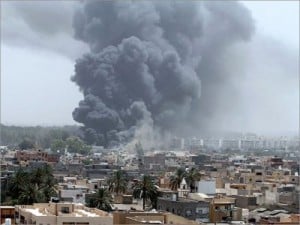
The amount of devastation caused by the Depleted Uranium (DU) weaponry used against Iraq during the consecutive US led wars is historically unprecedented in modern warfare. The devastating magnitude of the complications and damage caused as a result of the use of such radioactive and toxic weapons on the environment and the human population was intensified as a result of the intentional concealment, denial and misleading information released by the Pentagon about the quantities, characteristics, and Iraqi area’s within which these weapons were used.
Information revealed about a severe illness known as the ‘Gulf War Syndrome’ which spread amongst US Army veterans who were exposed to DU while using theseweaponry, helped Iraqi researchers and Medical Doctors to understand the nature of the effect of these weapons, and the means required to investigate further into this issue.
DU is a chemically toxic and radioactive heavy metal produced as waste by the nuclear power industry. It is used in weapons because it is an extremely hard material capable of piercing armor.
The synergistic impact on health due to the 1991post-Gulf War1 economic sanctions, and DU related radioactive and toxic contamination, raised the number of casualties in contaminated areas such as in Southern Iraq.
During 2003, the invading forces used additional rounds of DU in heavily populated areas such as Baghdad, Samawa, Fallujah, Diyala, Najaf, Salahuddin, Basra and Nasiriya (again), and other cities.
The continual use of DU after-Gulf War I in 1991, then during and after the US led military operations in 2003 invasion of Iraq increased the total contamination area with DU in Iraq. Consequently, civilians in previously contaminated areas received an extra dose of radioactivity after 2003. An action that can only be interpreted as committing unseen genocide against the unarmed civilian population in these areas.
Accordingly, hundreds of thousands of Iraqis have received higher doses of radioactivity than those received from standard natural sources of radiation. As a result, a multifold increase of diseases related to Low Level Radiation (LLR) exposure have been registered amongst Iraqis since 1995, including an increase of children’s leukemia, congenital malformations, breast cancer etc…
The leukemia incidence rates for instance, shifted towards younger children during these recent years, and its association with geographically distributed contaminated areas, offers strong evidence of the correlation between LLR exposure, and the resulting health damages.
Through this paper, an overview of major scientific DU conclusions will be presented, drawn from investigations and research conducted since the year 1991 by Iraqi researchers and MDs. This research was never published outside Iraq because of the comprehensive sanctions imposed on Iraq from (1991-2003). They were published only in Iraqi University peer reviewed journals and two related conferences. Schemes of the research papers can be classified into three categories:
- DU contamination detection and exploration programs.
- DU effects on human body cells.
- DU related epidemiological studies.
1.0 Introduction:
Depleted Uranium (DU) weaponry has been used against Iraq since the Gulf War 1 in 1991. An estimated (DU) expenditure of 320 – 800 tons were shot mainly on the withdrawing Iraqi troops from Kuwait to the north of Basra City [ 1].
The use of (DU) ammunition on Iraqi territory never stopped since 1991. Different generations of (DU) supported Tomahawk missiles & Bunker Buster Bombs [1] have been used during the 90’s on what were known as the No-Fly Zones (Northern & Southern regions of Iraq), and during the attack on Iraq in 1998. Bombing Iraq with DU continued during the military operations of the invasion of Iraq in 2003, then afterwards in other cities which resisted the occupation of Iraq [2].
With the comprehensive sanctions imposed on Iraq in 1991, the United States & its allies used radioactive & toxic weapons to exhaust Iraq’s institutions & population to prepare for the invasion of Iraq in 2003. Using extra hundreds of tons of (DU) expenditure during the invasion of Iraq made the radioactive contamination situation more complicated.
For many years the US-UK led armed forces avoided any release of information about the amounts, types, and locations of the targets destroyed by these weapons within Iraqi territories [2]. As a result, thousands of Iraqi children and their families in West Basra were repeatedly exposed for extended durations to DU low-level radiation (LLR) and toxic effects. Many researchers have found a direct correlation between this exposure, and the significant increase of certain diseases such as congenital malformations, malignancies, congenital heart diseases, chromosomal aberration, and multiple malformations in Basra [3].
Right after Gulf War 1, European and American Anti-DU activists and NGO’s issued many publications identifying the harmful effects of DU on-Gulf War veteran health and Iraqi population. These publications helped Iraqi researchers start a series of exploration research programs to define DU contaminated areas in Iraq, and to estimate the radiation doses the civilian population in Southern Iraq and the Iraqi troops located there were exposed to during military operations in 1991. The programs also set out to assess the risk level related to contamination levels in the surrounding environment.
These exploration research programs were performed under severely constrained conditions allowing very limited technical resources because of the US imposed economic sanctions on Iraq during the 90’s posing a serious scientific challenge at the time.
Conducting these researches under the tight conditions and very limited technical and other resources under the economic sanctions was a serious scientific challenge at the time since the American and British occupation forces:
- Forbidding any release of information related to types, amounts, and locations of targets destroyed by DU projectiles, and any statistics related to Iraqi army and civilian casualties after the occupation of 2003 [4].
- Refusal to clean up contaminated areas (as was performed by the same named troops) in Kuwait [5].
- International agencies were prohibited the right to conduct full (DU) related exploration programs and risk assessments by US led occupying forces [6] the way they did in Kosovo [7]. Such an act indicates that these forces are relying on time to dissipate these contaminants with the purpose that the evidence of this crime be lost. Such assessment with proper resources, experts, and technology would link, with conclusive evidence, the harmful health impacts with exposure to DU oxidesamong the population of the contaminated areas.
Using such weapon and related misleading information can be considered as war crimes. They represent grave breach of the Geneva Convention and international law becausethese weapons have caused and continue to cause undifferentiated harm and suffering to civilian populations in all contaminated areas long after the end of the military operations [8].
DU contamination mechanism and health impacts
Dr Rosalie Bertell, a radiology scientist wrote in 2006 [9]; when DU munitions hit the target, they ignite prophetically and generate heat that reaches a temperature of (3000-6000°C). This heat causes a sublimation of DU and other metals to form a gas or aerosol in the forming DU nanoparticles. The nanoparticles can cross the lung-blood barrier and gain entrance to the cells resulting in the creation of free radicals. This is an effect of ionizing radiation. The other effect of DU comes from the fact that it is classified as a toxic heavy metal. Heavy metal toxicity attacks the proteins in the human tissue cells which normally fights the free radicals and creates additional free radicals [9]. This causes an oxidative stress that leads to failure of protective enzymes, damaging the cellular communication system and the mitochondria. Free radicals can also disrupt the protein’s folding process of (DNA). This misrouting of proteins causes certain diseases such as cystic fibrosis, diabetes insipidus and cancer. The amassing and accumulation of misfolded proteins leads to neurodegenerative diseases like Parkinson’s disease. Gulf veterans have manifested many of the symptoms of these neurodegenerative diseases. Other effects are:
- Immune and Hormonal systems’ damage
- Distribution of thyroid function
- Mycoplasmal Invasion to human body
- Teratogenic Toxicity, where soluble DU oxides crosses the placenta to the fetus. As a result, damages might range from behavioral problems to mental retardation and congenital malformations.
Studies have shown that the Gulf War1 male veterans were twice as likely- and female veterans almost three times as likely- to report children with birth defects than counterparts who did not serve in the first Gulf War [9].
In her analysis, Dr. Bertell further emphasized that the carcinogenic properties of Uranium are linked the weakening the immune system of individuals, and showing that a depressed immune system often changes the status of subclinical cancer into clinically diagnosable cancer. Other related important studies related to these aspects are of Miller, A. et al [10] [11], Hindin et al [12], and Schroder [13].
The existence of radioactive DU oxides in these areasis considered ascontinuous source of exposure to both toxins and harmful radioactivity. It also represents a continuous and systematic attack on the civilian population each time DU oxide contaminated dust storm blow on the city of Basra and all surrounding areas tens of years to come.
In this paper, the genuine scientific efforts of the Iraqi scientists and researchers who tried hard to define DU contaminated areas in Southern Iraq after Gulf War 1 of 1991, and to show a correlation with its perceived consequences on general population health, all while under the US-UK led economic sanctions imposed on Iraq will be reviewed.
Most of these studies couldn’t find their way to internationally peer-reviewed journals because of the comprehensive sanctions imposed on Iraq, even though they have been published in Iraqi University peer-reviewed scientific journals in addition to the proceedings of two DU and War Consequences scientific conferences (1998, 2002).
It is also an obligation to let the world know that some of these studies cost the authors their lives after the occupation of Iraq in 2003. One of them is Dr. Alim Abdul Hameed Yacoub (Dean of Basra Medical College) who was killed, along with his son, when his car was forced off the highway on the way to his home town of Basra after being attacked and threatened twice at his home by pro-occupation militias two weeks before his death. They cost other researchers their freedom, such as Dr. Huda Ammash who was accused of being (Lady Anthrax) and imprisoned without any real accusation for 3 years just because she conducted very important research on Iraqi Armed Forces veterans who were exposed to DU weapons.
In addition to the assassination of about 500 Iraqi scientists after the US led invasion of Iraq by US trained Death Squads and pro-occupation militias, in what appears to be measures taken to discontinue any kind of scientific research in Iraq including DU-related research [14] in occupied Iraq.
2.0 Schemes of DU related research that have been conducted and published in Iraq (1991-2003):
Studies in this paper are classified into the following schemes:
- Detection and modeling of DU contaminated areas through site measurements and laboratory tests
- Epidemiological Studies Related to (DU) Contamination Health Effects.
- Pathological Studies of DU Effects on Human Health
2.1 Detection and modeling of DU contaminated areas through site measurements and laboratory tests
In 1993 the first Iraqi team of researchers from the Iraqi Atomic Commission and the College of Science in University of Baghdad [15][16] investigated with very limited information and a Sampling Program the increase of DU related radioactivity in selected areas West of Basra. Destroyed Iraqi tanks and vehicles contaminated upon destruction with DU ammunition were still laying around these areas. The areas included: Northern Rumaila oil fields, Al-Shamia, Kharanje, Southern Rumaila oil field, and Jabal Sanam. Exposure measurements revealed the existence of DU contamination in the studied areas. Tables 1, 2, and 3 show the results of these measurements. As we can see from the results not allsampled tanks and Iraqi artilleries have been destroyed by DU projectiles.
Table (1) Field Measurements of 1993 at North Rumela Area [15]
Table (2): Field Measurements of 1993 at Shamia Airfield /Khudairat al-Audhaimi Area [15]
Table (3): Field Radioactivity Measurements of 1993 at DMZ and Surrounding Area [15]
In 1996 Al-Azzawi, S.N. and her team conducted a comprehensive exploration program through the Environmental Engineering Department in University of Baghdad [17] [18] [19][20][21] [22][23]. The program involved taking hundreds of exposure measurements, soil and destroyed targets smear samples, surface water and channels sediments samples, bio-samples from vegetation cover, fish, and grazing animal tissues. Sampling included areas of heavy military engagement during the first Gulf War of 1991 such as Safwan, Jabal Sanam, al-Zubair, Northern Rumaila oil fields, and Southern Rumaila Oil Fields (Figures 1 and 2). The measurements and tests were part of the academic requirements of three Masters of Engineering degree thesis in Environmental Engineering.
A BGS-4 gamma-ray scintillation counter was used to measure onsite exposure. The counters were used for 124 field exposure measurements in and around the destroyed tanks and other military vehicles. High purity germanium detectors were used to test 124 soil and sediment samples, 58 surface and groundwater samples and 158 bio-samples in the Laboratory of Environmental Radiation in the Iraqi Atomic Organization. All field measurements were supervised and by specialists from Iraqi atomic energy organization and according to IAEA related standards. Also, all laboratory tests were conducted during continuous visits and checking of UN/US inspection teams to all the latter organization’s activities.
Selected measurements from 1996 exploration program results are shown in (Table 5). Modeling pollution transport from hundreds of destroyed artilleries to surrounding areas till 1996 shows the spreading of DU contamination in the area from 1991 – 1996 [17] [18] [19]:
- 1,718 km² of soil contaminated with DU oxides and particles,
- 140,000 m² of channel sediments,
- 845,100 tons of vegetation cover
Table 5: Selected Exposure and Soil Radioactivity Measurements From the 1996 exploration program [17] [18]
T: Destroyed Tank A: Destroyed Armored Vehicle
Risk assessment related to previous measurements showed that people in the Western part of Basra City, and the Iraqi and American troops received a total whole body radioactive dosage of (442 – 577) mSv [24], mostly during the first six months of the 1991 Gulf War military operations. Comparing this value with the background annual radioactivity vlue of (2.4 mSv) we can see that this amount is about 200 times more than normal natural radioactivity the human body receives. Findings of the predicted health damages related to these doses were defined and published at the time[25].
In 1999 – 2000 a follow-up exploration program in the same contaminated area of West Basra was conducted by (Al-Azzawi and Al Nuiamy, 2002) [24] [25]. The program included radioactivity measurements of site exposure, soil sediments, water samples, and laboratory tests. Samples were collected from previously studied areas plus areas where most of the DU contaminated tanks and wreckage were collected and unfortunately placed on the banks of Wafaa Al Qaied waterway causing further contamination.
Results of this program indicated the existence of higher than natural background radioactivity in some of the soil samples and sediments from nearby surface water channels sediments in the areas but in general the radioactivity was less than that of 1996. Sand and dust storms with the weathering process contributed to the dispersion of these contaminants to nearby populated areas.More than (127) days of dust storms used to hit that area since the Nineties of last century [26].
Also in 1999-2000 Al-Azzawi, Maarouf and Al-Mousori conducted an exploration program to check of the possibility of radiological contamination in Ninevah Governorate and its center Mosul City, after being attacked in 1998 by new generations of Cruise missiles (AGM 154 J50W) on three targets on the Eastern bank of Tigris River in Mosul city. The program also involved checking the extension of The Chernobyl Plume on Iraqi territories after 13 years [27].
The field measurements using Portable Scintillation Counter have proved that there is clear radiological pollution in the study area. The measured average exposure rate was 11.38 µR.h-1 in Mosul city and 10.11 µR.h-1 in Nineveh governorate which are more than the background level of the study area that amounted to 7.0 µR.h-1.
The laboratory tests have also shown an increase in Ra-226 concentrations which is one daughter of the decay series of U-238. The tested maximum concentration of Ra-226 is 146 Bq.kg-1 in Mosul City and 107 Bq.kg-1 in Nineveh governorate, while the background level calculated in these regions should be 55 Bq.kg-1. This is an indication that the increase can be attributed to the pollution of the study area by Uranium weaponry and that the missiles used to destroy these targets contain Uranium radioisotopes.
The Pentagon kept denying the existence of radiological contamination and the harmful effects of DU on human population and environment. They also accused the findings of the Iraqi research teams during the Nineties as (Iraqi regime propaganda).
After 4 years under the US occupation of Iraq comes the proof from the occupation assigned Iraqi government that all our work was genuine and scientifically credible.
During the National Meeting on Radiological Pollution in Iraq, held in Mansur Melia Hotel in Baghdad, the Minister of Environment in Iraq Narmeen Othman presented the results of the environmental radiological assessment that were conducted in 2007 in some areas of Iraq including Northern and Southern Oil Fields in Southern Iraq after a significant increase of registered cancer cases (as being mentioned in that meeting) [28]. Results of that assessment shows the following:
- In Rumaila Oil Fields 48 sites were found radiologically contaminated
- Among the 17 stations of Northern Rumaila Oil Fields, eight sites were found contaminated with radioactive radionuclide
- Also Phase one of that environmental radiological assessment showed 264 radiologically contaminated samples as follows:
- In Samawa area 202 samples were collected. 71 soil samples, 10 water samples, 106 dust smear samples. And one vegetation cover sample. Contaminated samples were 36 sample.
- In Zubair area, 62 samples. 41 of them contaminated.
- In Basra area, 103 samples. 62 samples were radiologically contaminated.
- In Nasrya area, 153 samples. 49 of them were contaminated.
It is noteworthy to highlight the fact that these findings come after 15 years of the original exploration programs we have conducted in these areas [ ] [ ].
Tawfiq, N. F. et al in 2000 [29] measured alpha-emitters concentrations in soil samples from different Iraqi cities using Solid State Nuclear Track detectors CR-39 and CN-85. Her team found high concentration radioisotopes measurements of (7.8) ppm in Muthana governorate (Samawa City).
The Dutch troops later in 2003 refused to camp in Samawa City, due to high DU related radioactivity detected by those troops [30]. After few days, they finally moved to a nearby desert area. It was also confirmed that New York Guardsmen serving in Samawa city during 2003 were exposed to DU [31].
Tawfiq research team also confirmed that other cities with higher radioisotope concentrations in soil than that of the area’s background levels which typically range in (1.02-2.2) PPM were: Basra (7.2) ppm, Nasirya (Al-Shatra city) (6.2) ppm. These locations fell on withdrawing Iraqi troops withdrawal route from Kuwait in Jan 1991. The same route the Iraqi troops were intercepted and destroyed by US DU weapons.
In 2000, Al-Gurabi, S. and her team measured DU related increases in radioactivity along the areas bordering Kuwait and Saudi Arabia. They also measured Northern Rumaila Oil Field and areas to the Northwest of Basrah City [32]. Results showed higher activity concentrations of DU related radioisotopes in all investigated areas except the center of Basrah City.
Butras, Wartan and Butras in (2000-2001) [33] measured radioactivity in three different areas of Basrah using Alpha and Beta measuring LB1200 detectors. The measured areas:
A: Iraqi-Saudi-Kuwaiti borders
B: Qurna city, Zubair city, Faw and Umm Kasir seaports.
C: Shatt Al-Arab district in Basra
Results proved the existence of higher radioactivity measurements than background levels of (18*10-3) mRem/hr in area (A) after 10 years of the war. Umm Kasir area registered (10 * 10-3) mRem/hr, compared to normal background levels in the area are within the range of (7 * 10-3) mRem/hr [33].
During the year 2000, Al-Kinani, et al [34] collected (11) soil samples from Safwan, Southern Rumaila and the unarmed border zone using a gamma radiation detector. Results indicated that (7) of these samples were contaminated with DU radioisotopes. Sample (SSI) U235/U238 ratio was found to be (0.00351) which indicates high DU contamination a destroyed tank in that area. Other ratios ranged between (0.0041-0.0037).
Dozens of other studies were conducted and published in Arabic or English peer-reviewed scientific journals of various Iraqi universities. Those published investigation programs were all conducted by well-known professors and researchers who followed the IAEA and other international scientific standards’ procedures. Researches and radiological laboratory tests that were done in conjunction with the environmental department of the Iraqi Atomic Commission were searched and reviewed by periodic UN inspection teams’ visits and the IAEA teams. These teamswere inspecting all the activities throughout the nineties until the invasion of Iraq in 2003.
The Radiation Protection Centre (RPC) has also identified between 300 and 365 contaminated sites by 2006. Most of them located in the Basra region in Southern Iraq [35 ]
2.2 Epidemiological Studies Related to (DU) Contamination Health Effects:
Many epidemiological studies were conducted in contaminated cities to define the correlation between (DU) contamination and the increase of malignancy incidence rates and congenital malformation in Basra Governorate for example. Most of these studies were performed by faculty members of Al-Basra College of Medicine since 1995. Some of these studies were published in the University of Basra Medical Journal. Others were presented in the two Iraqi conferences about the effect of economic sanction and (DU) weaponry used against humans and the environment in Iraq, held in 1998 and 2002 respectively.
Results of these studies pointed out a very clear trend concerning the existence of correlation between contamination and the resulted increase of the related diseases in geographically contaminated areas. Among others, the following studies are specifically important:
- Alim Yacoub et al, 1998 [36] [37] presented an analysis of recorded cases of registered malignant diseases among children under 15 years of age in Basra for the period (1990 – 1997). This analysis showed a rise of 60% in children’s leukemia from 1990 to 1997. Also, a 120% increase in all malignant cases among children under the age of 15 for the same period were registered. The study also showed the shift of age distribution of leukemia cases towards younger than 5 years of age from 13% in 1990 to 41% of total cases in 1997.
- Al-Sadoon, et al, 1998 [38] showed a threefold increase in congenital malformations registered cases in 1998 compared to 1990 in Basra city. Congenital heart diseases, chromosomal aberrations, and multiple malformations all indicate exposure to teratogenic environmental factor.
- Alim Yacoub, et al, 1999 [39] also introduced an analysis of the incidence and pattern of malignant diseases in Basra from the analysis of the histopathological reports of Basra University Teaching Hospital for the period 1990-1997.
The study indicated that there was a rise of about 160% in reported cases of uterine cancer in 1997 compared to 1990 and an increase of 143% in thyroid cancer cases in 1997 compared to 1990 recordings. Also, a 102% increase in breast cancer and 82% rise in lymphomas in 1997 compared to 1990.
The records also indicated a shift in the types of the five major leading malignancies in Basra in 1997 such as breast, bladder, lymphomas, uterine, and skin cancers. While those of 1990 were malignant diseases of bladder, skin, breast, lung, and larynx.
- Alim Yacoub, Imad Al-Sadoon and Jenan Hasan, 2002 presented a paper [40] that examines the association between exposure to DU radiation and the rising incidence of malignancies among children in Basra through time sequence criteria, and dose-response criteria through the geographical shift of the increase of incidence rates in Al-Zubair and other Western areas from less than 5/100,000 prior to 1993 to 22/100,000 in 2000 compared to only Al-Hartha area (North of Basrah) only prior to 1993 (with the highest incidence rates of 10/100,000 in 1993). They also tested the biological plausibility criteria through the shift of the increase of leukemia incidence rate towards younger ages of less than 5 years old after 1995.
Yacoub et al, 2002, couldn’t explain the reason behind the constant increase of malignancies incidence rates among children in Al-Hartha district in Northern Basra City, figure from (10 incidents / 100,000) to (42.7 / 100,000) in the year 2000.
This increase can be attributed to the existence of the largest electrical power generation and transformation facilities in Iraq of 800 MW. This power plant was destroyed during air raids several times first week of bombing in 1991. Nobody measured the radioactivity in Al-Hartha power plant, which might be also destroyed with DU expenditure.
We must be aware that these epidemiological studies were limited to Basra General Hospital, which is the education hospital of Basra Medical College. The mentioned number of cancer incidence cases and congenital malformations would be a lot higher if the studies involved all hospitals of Basra.
- Abbas Ali & Jawad al Ali, 2002 [41] presented an evaluation of chronic myeloid leukemia (CML) annual incidence which started to rise from 1995 up to the year 2000, when the increase began to plateau.
- Pathological Studies of DU Effects on Human Health
Dr. Huda Ammash- Professor of Molecular Biology in the College of Science in University of Baghdad, 1998, presented a paper on the mechanisms of toxicity induced by free radicals resulting from irradiation with DU and ionization of the atmosphere in Iraq [42] [43]. This paper pinpointed the need for DU toxicity studies on enzymes (SOD), Caralase, hydrogenates and Glyceraldehydes Dehydrogenates levels. She also presented the multi aborative cases on the DNA level where out of 50 studied cases, 29 cases were found with DNA abnormalities (with no hereditary evidence). Other multi aborative cases investigating the toxoplasmosis effect showed that out of 130 cases, over 65% more were infected than those recorded in 1989.
Muhammed, Z.T. et al, 2002, [44] published a paper about the effects of DU radiation on the human immune system enzyme. A group of (26) Iraqi veterans who were exposed to DU radiation with (43) control individuals were all subjected to tests for Adenosine DA Amines (ADN) enzyme activity. Results indicated mean activity of the enzyme of the exposed individuals of (0.184 ±0.016) U/gm protein, while the unexposed individual’s enzyme activity (0.291 ±0.022) U/gm protein.
ADA enzyme activity in the exposed individuals were found to be significantly lower than the control group. P<0 .05="" activity="" ada="" an="" and="" as="" between="" cellular="" clinical="" coefficient="" correlation="" defective="" enzyme="" found="" functions.="" immune="" important="" p="" related="" significant="" signs="" symptoms="" to="" was="">
Ammash, H., Alwan, L. and Marouf, B.A.,2002, published a paper (in Arabic) [45] about the results of Genetic hematological analysis for a group of individuals who live in DU contaminated areas in Southern Iraq. Blood tests for the (47) individuals who lived in Basra contaminated areas and other (30) individuals as a control group who lived in Baghdad. The research included other clinical and correlated factors.
Blood tests included hemoglobin concentration, packed cell volume test (PCV), total count (WBC) test and chromosomal changes and defects tests. Factors such as exposure type and exposure time due to nature of work were taken into consideration (45% of the studied groups are from Iraqi troops who were involved in military engagements of the Gulf War 1). The others were civilians who lived in contaminated areas.
The test results of the study clearly showed that a 21% of the studied individuals in Basra group suffered a reduction in hemoglobin concentration of (9-13) g/dl.
The other 79% of the individuals from Al-Basrah studied groups with normal hemoglobin concentrations of (12-15) g/dl and (13-18) g/dl for males and females in the group respectively.
The blood Packed Cell Volume (PCV) test results showed that 25.5% of the Basrah study group showed abnormal (PCV) rates of (30-39) % less than the normal rate. One male’s individual blood (PCV) was 3% higher than normal. Other individuals’ blood (PCV) in the studied group had normal rates ranging between (40-54) %.
Total count of white blood cells (WBC) test results showed that 8% of the individuals in the Basrah study group had less than normal (WBC) which is 4000 c/ml or higher than the normal rate or (11000) c/ml. Control group individuals all had normal (WBC).
Compound chromosomal changes in the lymphocytes of peripheral blood of the individuals of the Basra study group had been found to have a ratio of (0.1118) % which is significantly higher than that of the control group. The ratio of dicentric and ring centric chromosomal abnormality fraction was found to be (0.04479) which is also higher than the ordinary ratio. Chromosomal damages were mostly in male veteran individuals. One case was that of a 13-year-old at the time of exposure in Al-Zubair contaminated area.
From the Veterinary College of Basra University, Khadier, A.A. et al, 2000[46] conducted a study to detect levels of DU related radioactivity in pastures and animals within the contaminated areas of Safwan, Al-Zubair, N. Rumaila, Jabal Sanam, Kharanj Village, etc.
Blood samples from sheep and other grazing animals were collected. Analysis of blood samples using Lyoluminescence and Track Detectors proved the existence of very small concentrations of radioisotopes in a few sheep that fed from and around the destroyed artillery and tanks within the studied areas. It is believed the polluted dust on the leaves was the source of radioisotopes in the tested blood samples.
Al-Sadi, H.I. and Sawad, A. 2002 [47] from the Veterinary College of the University of Basrah also presented a study about the pathological conditions of the animals in Basrah. The study reported the existence of three types of animal neoplasm; seminoma in rams, mesotheliomas in buffalo, and ovarian cystadenomas in female dogs.
These types of neoplasms have never been reported in these regions before the Nineties. Also, some types of congenital defects in farm animals have been described.
2.4 Other related studies after the occupation of Iraq (post 2003)
The American and British armed forces used Depleted Uranium weapons during the military operations of Iraq’s invasion and occupation in 2003. As usual they wouldn’t admit or release information where and the amounts they have used to prevent the civilian population the extra exposure to more of these toxic and radioactive munitions. The UK government in 2010 admitted that British forces fired less than three tons of DU in 2003 [48].
The American armed forces kept lying and misleading the public until the findings of a DU related research published by the European organization PAX in collaboration with the ICBDUW and George Mason University of America. The research confirmed the use of about 181000 shells of depleted uranium or about 200 tons (Wim Zwijnenburg and Doug Weir, 2016). The research also identified the places where it was used [2]. Maps and illustrations showed that US forces fired these DU projectiles in most densely populated cities this at the time, including Basra, Baghdad, Najaf, Amarah, Tikrit, Karbala, Falluja and Baquba, as shown in Figure 5.
Figure 5: Areas bombed by DUweapons during the 2003 Iraqi occupation in 2003[2].
In 2006 and 2007 technical staff from the Iraqi Radiation Protection Centre collected environmental samples at four selected sites in Southern Iraq, namely As Samawah, Al Nassiryah, Al Basrah and Al Zubayr [49]. Since no information from US/UK armed forces defines where they used the DU ammunition in 2003!!because this information wasreleased in 2016 [2]. It seems clear that the samples were collected from previously identified DU contaminated areas of 1991.
A total of 520 samples of soil, water, vegetation, and smear tests, were taken. collected samples were shipped from Iraq to the Spiez Laboratory in Switzerland, which, on behalf of UNEP, analyzed them using Inductively Coupled Plasma-Mass Spectroscopy (ICP-MS). The radioanalytical results were then made available to the IAEA to make a prospective estimation of the radiation doses to the Iraqi population living in the above-mentioned four locations and the associated radiological risks [49].
The results of that very limited investigation program stated that:
“annual radiation doses to the public that could arise from the various types of exposure scenarios were calculated. based on the measurements carried out on the samples collected in this study. The radiation doses from DU were found sufficiently low not pose a radiological hazard to the population living at the four studied locations” [49 ].
That meansIAEA built their dose calculations on measured radioactivity in 2006, while contamination in these areas exist since 1991 (because all these areas were included in our exploration programs and researches in the Nineties as mentioned previously) [17] [18 ] [29] The risk assessment should have included cumulative radiation doses of all paths for the period 1991 to 2006, and not as they calculated from the instant they measured in 2006 (as an isolated event).
Soil concentration and activity values of the contaminants also should have been calculated back to their 1991 values and not its value in 2006 where its been dissipating and decaying for more than 15 years.
The risk assessment calculations IAEA adopted, depending on the following pathways [49 ]:
I Inhalation of soil re-suspended by the action of wind or human activities;
II Inhalation of re-suspended dust inside military vehicles hit by DU munitions;
III. Ingestion of soil;
- Ingestion of vegetables;
- Ingestion of and drinking water.”
Remember that in IAEA risk calculations they considered the exposed population live above these areas??, while dominant wind direction in Iraq and during dust storms is NW-SE [50]. That means they should have measure additional doses from contaminants blowing down from Samawa city on Nasiriya, Basra, and Zubair cities from 1991-2006, and so on of all other cities, check locations of these cities in figure.
Figure 5: Map of Iraq showing locations of cities involved in IAEA risk assessment(Samawa, Nasiriya, Basra, and Zubair).
IAEA risk assessment missed two other important pathways:
- Ingestion of contaminated meat, milk, and other items of food chain.
- Absorption of DU oxides through skin and immersion in emitted Radon cloud.
If we take all these factors in the calculation of the risk assessment the value would be hundreds of times higher than what IAEA team calculated.
During 2004 and 2005, after the US military assault on Falluja and the destruction of more than 50% of it, tests on city residents who had children or lost embryos suffered from congenital malformations showed that there were more concentrations of uranium than normal in their bodies (Alaani et al.,2012) [51]
Alaani et al, 2012 [52] published results have drawn attention to increases in congenital birth anomalies and cancer in Fallujah Iraq blamed on teratogenic, genetic and genomic stress thought to result from depleted Uranium contamination following the battles in the town in 2004. Hair samples from 25 fathers and mothers of children diagnosed with congenital anomalies were analyzed for Uranium and 51 other elements suggest the enriched Uranium exposure is either a primary cause or related to the cause of the congenital anomaly and cancer increases. Thus, raised about the characteristics and composition of weapons now being deployed in modern battlefields.
Chris Busby, Malak Hamdan, and Entesar Ariabi, 2010 [53] Published a paper that concludes results confirm the reported increases in cancer and infant mortality which are alarmingly high in Falluja. Also, the paper confirms a remarkable reduction in the sex ratio in the cohort born one year after the fighting in 2004 identifies that year as the time of the environmental contamination.
Samira T. Abdulghani, et al. [54] paper about “Perinatal and neonatal mortality in Fallujah General Hospital, Fallujah City, Anbar Province, west of Iraq.” Scientific Research, Open Access. http://www.scirp.org/journal/OpenAccess.aspx.
Dr Jawad al Ali, 2005 [55] published a paper about variable degrees of increased rates of cancers in Basra, particularly breast cancer, lymphomas, lung, colo-rectal ovaries, soft tissues and kidneys.
He added that Cancers which show no increase include the cancers of stomach, uterus and skin cancers. The overall incidences over the year showed tangible increase particularly during the year 2005.
Geographical distribution: the highest rate was in the west of Basra followed by the center of Basra, eastern area and the lowest is at the northern area. The age risk: the data showed massive increase in risk with age. The lowest rate is for the children less than five years (11.4/100.000). The highest rate was for the age group more than 65 years
(541.9/100.000). The total incidence rate was 59.1/100.000.
Conclusion
- The USA and UK continuously used Depleted Uranium weapons against the population and environment in Iraq from 1991 until today.
- Occupation intentionally denied and covered up the types, locations and amounts of DU projectiles that have been used in Iraq to prevent taking measures that could have reduce health damages on civilians resulting from the exposure to cumulative doses of these contaminants.
- Occupation forces prohibited UNEP, WHO and other international agencies to conduct any exploration programs to detect DU contamination and assess the health risks and clean up remedies during the way it has been conducted in Serbia and Kosovo.
- Forbidding the release of any casualties statistics by the health ministry of the occupation assigned government in Iraq right after the occupation of Iraq is another crime to cover up the magnitude of human lives losses related to the occupation of Iraq.
- Exploration programs and site measurements proved without a doubt that the existence of DU related radioactive contamination all over most of Iraq (except the northern area of Kurdistan).
- Published epidemiological studies in Basrah introduced a clear correlation between DU related exposure and the multifold increase of malignancies, congenital malformations, and multiple malformations among the population in DU contaminated areas.
- Other pathological and hematological studies indicated the existence of chromosomal and DNA aberrations and abnormalities in the 1991 Iraqi Gulf War veterans. Other studies proved their effects on lowering the activities of the human immune system in exposed individuals.
- Intentional continuous use of DU against the people and environment of Iraq is a crime against humanity due to its undifferentiated harmful health impacts on civilian long times after the military operations. Existing DU contamination in the surrounding environment is a continuous source of exposure to civilian’s population, and can be considered as systematic attacks on civilians in each DU contaminated dust storm blown on these cities. Article 4 of the official regulations and Article 7 of the ICC.
Notes
[1] William, Dai. 2002. “Hazards of Uranium weapons in proposed war on Iraq”, sept. 22nd, 2002. The Eos life-work resource center.
Updated 27 October 2002. http://www.eoslifework.co.uk/u231.html.
[2] Wim Zwijnenburg and Doug Weir, 2016. Targets of Opportunity; Analysis of the use of depleted uranium by A-10s in the 2003 Iraq War. A joint investigation by PAX and ICBUW. Published on www.paxforpeace.nl website.
[3] Asaf Durakoviæ.1999.” Medical Effects of Internal Contamination with Uranium”. CMJ online. March 1999 (Volume 40, Number 1).
http://www.fukuleaks.org/edanoleaks/Scribble_Japan_Earthquake/pdfs/medical_effects_cmj.pdf.
[4] USA Today, 2003, Iraq’s Health Ministry ordered to stop counting civilian dead from war, Dec. 12 2003.
[5] Kirby, A., 2003, “US rejects Iraq DU clean-up”, BBC news online, April 14th 2003.
[ 6] Sunday Herald, “WHO suppressed scientific study into depleted uranium cancer fears in Iraq”. Feb 22, 2004.
[7] Depleted Uranium sites in Kosovo detailed by UNEP. http://www.unep.org/Documents.Multilingual/Default.asp?DocumentID=189&ArticleID=2741.
[8] Karen Parker, 2007.”War Crimes Committed by the United States in Iraq and Mechanisms for Accountability”. Consumers for peace. Oct.10, 2007.
[9] Rosalie Bertell, 2006. “Depleted Uranium: All the Questions about Du and Gulf War Syndrome are Not Yet Answered”. International journal of Health services.
[10] Miller, A. et al. “Genomic instability in human osteoblast cells after exposure to depleted Uranium: Delay lethality and micronuclei formation”. Journal of Environmental Radioactivity. vol.64(2-3), 2003 (PP 247-259).
[11] Miller, A. et al, “Effect of the military-relevant heavy metal, depleted uranium and heavy metal tungsten-alloy on gene expression in human liver carcinoma cells (HepG2).” Mol. Cell Biochem. vol. 255(1-2). Jan. 2004 (PP. 247-56).
[12] Hindin, R., Brugge, D. and Panikkar, B. (2005), ‘Teratogenicity of Depleted Uranium aerosols: A review from an epidemiological perspective’, Environmental Health: A Global Access Science Source, 4:17, http://ehjournal.biomedcentral.com/articles/10.1186/1476-069X-4-17.
[13] Chroder, H. et al. “Chromosome aberration analysis in peripheral lymphocytes of Gulf War and Balkans War veterans”. Radiation Prot. Dosimetry. Vol. 103(3) 2003 (PP. 211-219).
[14] Spanish Campaign against the Occupation and for the Sovereignty of Iraq.
Iraq Solidaridad 2005-2013. “The killing of Iraqi Academics: A War to Erase the Future and Culture of Iraq.” List of Iraqi academics assassinated in Iraq during the US-led occupation. http://www.iraqsolidaridad.org/wordpress/wp-content/uploads/2013/11/List-of-Iraqi-academics-assassinated-November-2013.pdf.
[15] International Conference on DU, 2000, “Health, ecological, legal, and economic aspects of conventional radioactive weapons”, Committee of Solidarity with the Arab Cause, Nov. 26-2, 2000, Gehone, Spain.
[16] Iraq Foreign Affairs Ministry, 1995, “Radiation effects”, an official paper submitted by the Iraqi delegation to the briefing meeting on nuclear liability during the 42nd Session of the General Conference, Vienna, 1995.
[17] Al-Azzawi, S., Maarouf, B., Seleh, M.J., Al-Saji, M., Al-Hilli, W., and Maguar, A., 1997. “Damages resulted from the use of DU weaponry against Iraq”. Technical Report published in Arabic, Environmental Engineering Dept. College of Engineering, University of Baghdad. Baghdad, Iraq, 157pp.
[18] Al-Azzawi, S.N., Ma’arof, B.A., Mahmmod, M.A., Al-Hili, W.M., Al-Saji,, M., Jada’an, A.M. 1999. “Environmental Pollution Resulting from The Use of Depleted Uranium Weaponry Against Iraq in 1991.” Journal of Arabic Universities Association. College of engineering. University of Baghdad, vol. 6, no. 2, Baghdad, Iraq. Published in Arabic. Pp.47-62.
[19] Al-Azzawi, S. et al, “Environmental Pollution Resulting from the Use of Depleted Uranium Weaponry Against Iraq During 1991, World International Conference on DU, Hamburg, Germany, 2003.
[20] Al-Azzawi, S., and Al-Saji, M., 1998. “Effects of DU radioactive pollution on surface and ground water in selected regions in southern Iraq”. Journal of Arabic Universities Association, vol. 6, no. 1, Baghdad. Iraq. (Arabic language).
[21] Al-Hilli, W., 1998. “Effects of radioactive weapons on soil and air quality in Iraq”, M. Sc. Thesis in environmental engineering. College of Engineering. University of Baghdad. Baghdad, Iraq, 1998.
[22] Al-Saji, M., 1998, “Effects of radiological weapons on surface and groundwater quality in selected areas southern Iraq”. M. Sc. thesis in environmental engineering. College of Engineering, University of Baghdad, Baghdad, Iraq.
[23] Maguar, A.,1998. “Effects of radiological pollution on human and living environment in southern Iraq”. MSc. thesis, environmental engineering. College of engineering. University of Baghdad, Baghdad, Iraq.
[24] Al-Azzawi, S., and Al Naemi, A. 2002, “Assessment of radiological doses and risks resulted from DU contamination in the highway war zone in al-Basrah governorate”. Proceedings of the conference on the effects of the use of DU weaponry on human and environment in Iraq. March 26-27/ 2002. Baghdad, Iraq.
[25] Al-Azzawi, S., and Al Naemi, A., 2002, “Risk assessment related to radiological contamination resulted from the use of DU ammunition in al-Basrah war zone”, proceedings of the conference on the effects of the use of DU weaponry on human and environment in Iraq, March 26-27, 2002, Baghdad, Iraq.
[26] TW, 2016.” Significant increase in frequency and intensity of sandstorms in the Middle East over the past 15 years”. The Watchers Website (WT). June 17, 2016.
[27] Al-Azzawi, S., Maarouf, B., and Mazouri, N., 2002. “Environmental radiological pollution from the use of DU weaponry against Ninevah governorate during the war”, proceedings of the conference on the effects of the use of DU weaponry on human and environment in Iraq, March 26-27 2002, Baghdad, Iraq.
[28] Hadi al Rubaiay, 2009. “Depleted Uranium is Innocent until Prove its Guilt”. National meeting of the consultants committee of Prime Minister Office on radiological pollution in Iraq. Mansour Melia hotel. Iraqi Media Network Report in Arabic.
file:///H: ف%20الندوة%20الوطنية%20للوقاية%20من%20التلوث%20الاشعاعي..%20اليورانيوم%20الhtml.
[29] Tawfiq, N., et.al., 2002, Determination of Alpha-emitters in Iraqi soil samples using solid state nuclear track detectors CR-39 and CN-85, Proceeding of Conference on the Effects of DU Weaponary on Human and Environment in Iraq, March 26-27, 2002, Baghdad, Iraq.
[30] ICBUW, 2006.” Dutch military in Iraq delays troop transfer from suspected DU contaminated area”. International Coalition to Ban Uranium Weapons. Sept. 29. 2006.
http://www.bandepleteduranium.org/en/dutch-military-in-iraq-delays-troop-transfer-from.
[31] Joanne, L., 2004, “Testing of New York guardsmen: first confirmed cases of Iraq war depleted Uranium exposure”, World Scientist web-site; http://www.wsws.org/articles/2004/apr2004/dwica-a21.shtml.
[32] Al Ghurabi, S. et. al., 2002, “DU pollution in southern Iraq after ten years”. Proceedings of the Conference on the effects of the use of DU weaponry on human and environment in Iraq. published in Arabic. Vol. 1, March 26-27, 2002, Baghdad, Iraq
[33] Butrus, S., Wartan, K., and Butrus, L., 2002, “Assessing radioactive contamination levels in Basrah governorate”. Proceedings of the conference on the effects of the use of DU weaponry on human and environment in Iraq, March 26-27, 2002, Baghdad, Iraq, published in Arabic.
[34] Alkinany, A., Twege, D., and Abdul Allah, K., 2002, “Investigating DU radioactivity in selected locations in Basrah”. Proceedings of the conference on the effects of the use of DU weaponry on human and environment in Iraq, March 26-27, 2002, Baghdad, Iraq, published in Arabic.
[35]The Guardian, 2013. “Iraq’s depleted uranium clean-up to cost $30m as contamination spreads”. March 6, 2013.
[36] Yaqoub, A.A., Al-Sadoon, I., and Hassan, J., 1998. “Incidence and pattern of malignant diseases among children in Basrah with specific reference to leukemia during the period of 1990-1998”. Proceeding of the conference on health and environmental consequences of DU used by U.S. and British forces in the 1991 Gulf War, Dec. 2-3, 1998, Baghdad, Iraq.
[37] Yaqoub, A., et.al., 1999. “Depleted Uranium and health of people in Basrah: an epidemiological evidence; 1-The incidence and pattern of malignant diseases among children in Basrah with specific reference to leukemia during the period of 1990-1998”. Medical journal of Basrah University (MJBU). Vol.17, no.1&2, 1999, Basrah, Iraq.
[38] Al-Sadoon, I., Hassan, J., and Yaqoub, A., 1998. “Incidence and pattern of congenital anomalies among birth in Basrah during the period 1990-1998”. Proceeding of the conference on health and environmental consequences of DU used by U.S. and British forces in the 1991 Gulf War. Dec. 2-3, 1998. Baghdad, Iraq.
[39] Yaqoub, A., Ajeel, N., and Al-Wiswasy, M., 1998. “Incidence and pattern of malignant diseases (excluding leukemia) during 1990-1997”. Proceeding of the conference on health and environmental consequences of DU used by U.S. and British forces in the 1991 Gulf War. Dec. 2-3, 1998. Baghdad, Iraq.
[40] Yaqoub, A., Al-Sadoon, I., and Hassan, J., 2002. “The evidence of casual association between exposure to DU and malignancies among children in Basrah by applying epidemiological criteria of causality”. Proceedings of the conference on the effects of the use of DU weaponry on human and environment in Iraq. March 26-27, 2002. Baghdad, Iraq.
[41] Ali, A., and Al-Ali, J., 2002. “Chronic myeloid leukemia in Basrah after the Gulf War II”. Proceedings of the conference on the effects of the use of DU weaponry on human and environment in Iraq. March 26-27, 2002. Baghdad, Iraq.
[42] Ammash, H., 1998. “Mechanism of toxicity induced by free radicals resulting from irradiation with DU and ionization of atmosphere in Iraq”. Proceeding of the conference on health and environmental consequences of DU used by U.S. and British forces in the 1991 Gulf War.Dec. 2-3, 1998. Baghdad, Iraq.
[43] Ammash, H., 2000. “Toxic pollution, the Gulf War, and sanctions, the impact on the environment and health in Iraq”. Iraq under Siege, editor: Anthony Arnove, South End Press, Cambridge, Mass, 2000.
[44]Mohammed, Z., et.al., 2002. “Detection of DU effects on human by use of immune system enzyme”. Proceedings of the conference on the effects of the use of DU weaponry on human and environment in Iraq. March 26-27, 2002. Baghdad, Iraq.
[45] Ammash, H., Alwan, L., and Maarouf, B., 2002. “Genetic hematological study for a selected population from DU contaminated areas in Basrah”. Proceedings of the conference on the effects of the use of DU weaponry on human and environment in Iraq. March 26-27, 2002. Baghdad, Iraq.
[46] Khudair, A., Abdul Kader, K., and Al-Taha, T., 2002. “Study of the radiological pollution level in pastures of Basrah in 2000”. Proceedings of the conference on the effects of the use of DU weaponry on human and environment in Iraq. March 26-27, 2002. Baghdad, Iraq.
[47] Al-Sadi, H., and Sawad, A., 2002. “Some interesting pathological conditions in animals in Basrah and the possible etiological role of DU used in 1991 aggression against Iraq”. Proceedings of the conference on the effects of the use of DU weaponry on human and environment in Iraq. March 26-27, 2002. Baghdad, Iraq.
[48] RT, 2010.” Reports emerge the UK used depleted uranium weapons in Iraq”. Russia Today New. July 23. 2010. https://www.rt.com/news/uk-iraq-depleted-uranium/.
[49] Danesi1,P.R.,and Telleria2, D.M ,2006. “Radiological Conditions at Four Selected Sites in South Iraq with Residues of Depleted Uranium”. 1, International Atomic Energy Agency Consultant, Vienna, Austria. 2International Atomic Energy Agency, Vienna, Austria.
file:///H:/DU%20contamination%20doses%20in%20southern%20Iraq%20measured%20for%20UNEP%202003.pdf.
[50] Tara Mohamed Anwar. “ Country Pasture/Forage Resource Profile. Iraq”.
[51] Alaani, S., Tafash, M., Busby, C., Hamdan, M., and Blaurock-Busch, E., 2011. Uranium and Other Contaminants in Hair from the Parents of Children with Congenital Anomalies in Fallujah, Iraq. Conflict and Health, V.5; 2011, PMC3177876.
[ 52] Busby C, Hamdan M, Ariabi E. 2010. Cancer, Infant mortality and birth sex ratio in Fallujah, Iraq 2005-2009. Int. J. Environ Res. Public Health 7, 2828-2837.
[53] Alaani S, Savabieasfahani M, Tafash M, Manduca P. 2011. Four polygamous families with congenital birth defects from Fallujah, Iraq. Int. J. Environ Res Public Health 8, 89-96.
[ 54] Al-Ali, Jawad, 2005. “Epidemiological study at Southern Iraq, Basra city”. Proceeding of the Cancer trend in Basra, Iraq. Depleted uranium – 4.5-billion-year health risk meeting. At 17-20 Auditorium in the Parliament House, Japan. Sept 12. 2006.
All images in this article are from the author.
The original source of this article is Global Research
Copyright © Prof Souad N. Al-Azzawi, Global Research, 2017
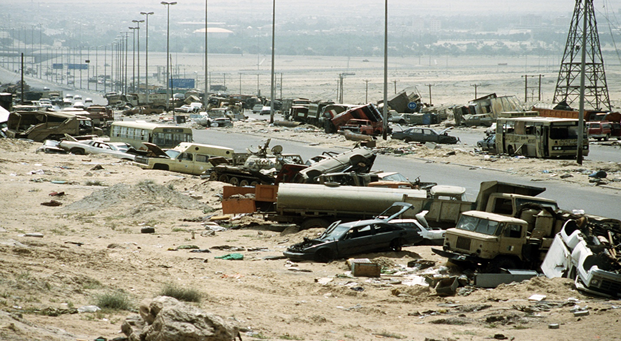
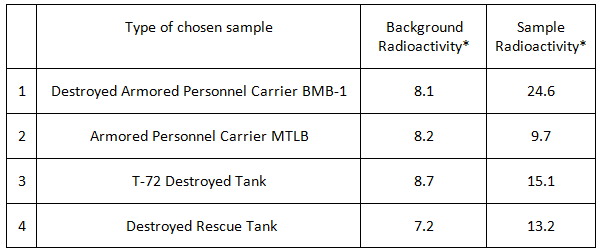
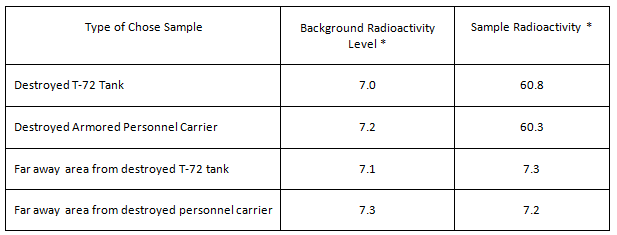
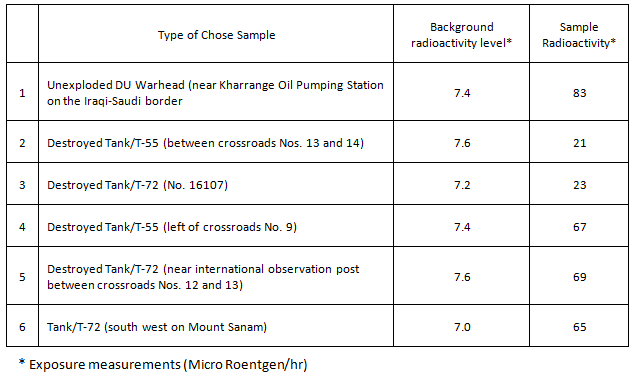
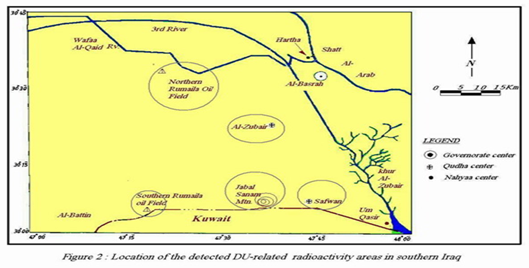
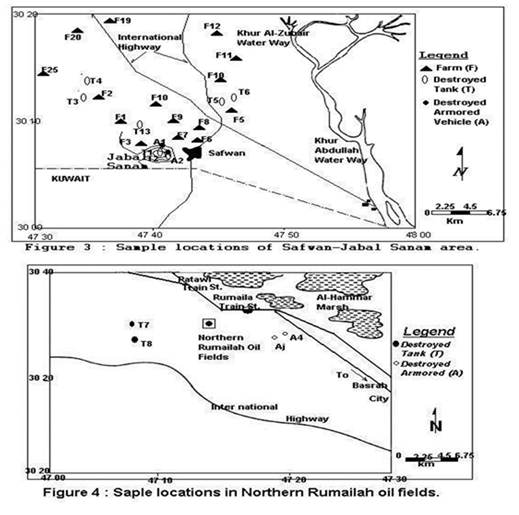

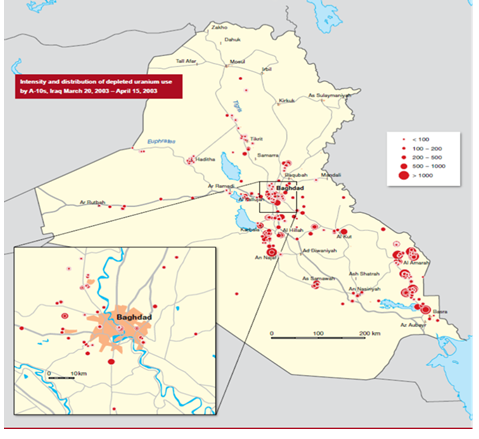
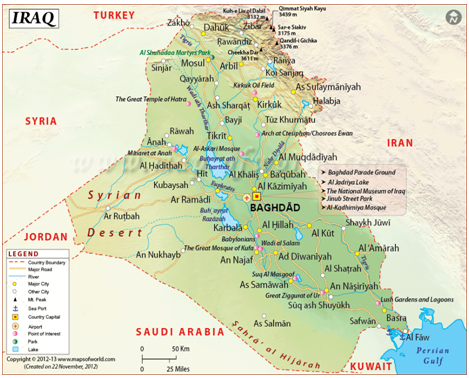



Geen opmerkingen:
Een reactie posten